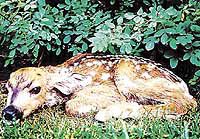| Residents who find deer fawns are encouraged to leave them alone and undisturbed. Their mother is probably nearby and will tend to the fawn soon after the humans leave. |
Late May is a critical time for deer and elk in Utah, as female animals are giving birth to and caring for fawns and calves.
Disturbance, including that caused by off-highway vehicle riders who take off highway vehicles off of roads and trails that are open to their use, is one thing the animals don’t need.
“Deer and elk seek seclusion to have their young, and we need to give them that,” advised big game coordinator for the DWR, Jim Karpowitz. “If we don’t, we’re causing them stress that they don’t need.”
Karpowitz says disturbance can frighten mothers away from their young when the fawns and calves need them the most.
“For the first few days after being born, fawns and calves can barely stand up. They’re basically helpless. They need regular visits from their mothers to get the nourishment they need to help them grow.”
In addition to stressing animals, taking these recreational vehicles off of designated roads and trails causes serious habitat damage that can take years to repair.
“During the spring, many plants are just starting to grow and are very susceptible to damage by off highway vehicles. Soil erosion is another big concern,” Karpowitz stated.
Another concern Karpowitz has are off highway vehicle riders finding fawns and calves and bringing the animals home with them, because they think the animal has been abandoned.
“If a recreationalist finds a young animal by itself, that’s not unusual,” Karpowitz stated. “The female beds the young animal down and then goes away so she won’t attract predators to the baby. The only time she visits the baby is to nurse it.”
“If a fawn or calf is found, the best thing to do is leave the baby where it is found. Its mother will be back soon to care for it.”
One challenge some off highway riders have is knowing where they can ride their OHVs legally.
Fortunately, this information is available from many sources. One of the best places to start is the highlights of Utah’s off-highway vehicle laws and rules brochure published by the Utah state parks division.
The brochure lists 25 popular motorcycle and all-terrain vehicle trails in Utah, and provides information on which U.S. Forest Service or Bureau of Land Management office to call for trail and riding maps for each area.
The brochure is also available at the state parks Internet website at www.stateparks.utah.gov or by calling their office at 800-648-7433.
Trail and riding maps are also available for other areas in Utah and riders can learn how to obtain them by calling the nearest U.S. Forest Service or BLM office.

